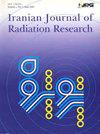内镜逆行胰胆管造影术中患者和检查者的辐射暴露
Q4 Health Professions
引用次数: 0
摘要
背景:内镜逆行胰胆管造影(ERCP)目前广泛应用于胃肠道疾病的诊断和治疗。大量的X射线透视和数字射线照片使ERCP成为一种介入放射学程序。在这项研究中,在诊断和治疗过程中测量了患者和检查者的进入皮肤剂量(ESD),并计算了患者的有效剂量(ED)。材料和方法:采用热发光剂量计(TLDs)和剂量-面积乘积仪(DAP)测量了30例患者和检查者的ESDs,并计算了患者的ED。此外,为了评估额外的铅屏蔽在减少检查者ESDs方面的有效性,在X射线管周围包裹了铅盖。数据采用IBM SPSS Statistics 16版软件进行分析。结果:诊断程序的平均DAP和荧光检查时间(FT)分别为4.09Gy.cm和32.4s,而治疗程序的DAP和FT分别为7.60Gy-cm和76.2s。计算患者诊断程序(1.21±0.52 mSv)和治疗程序(2.25±1.72 mSv)的平均ED。此外,X射线管周围的屏蔽罩降低了除性腺外的感兴趣器官的ESD。结论:研究结果表明,与诊断性ERCP相比,治疗性ERCP手术施加了更大的辐射剂量。然而,患者和检查人员的剂量在很大程度上取决于检查人员在辐射防护方面的经验、技术技能和知识。研究结果表明,应该设法减少辐射剂量。本文章由计算机程序翻译,如有差异,请以英文原文为准。
Radiation exposure to patients and examiners during endoscopic retrograde cholangiopancreatography procedures
Background: Endoscopic retrograde cholangiopancreatography (ERCP) is now widely used in the diagnosis and treatment of gastrointestinal tract disorders. A large number of X-ray fluoroscopy and digital radiographs make ERCP as an interventional radiological procedure. In this study, patients' and examiner's entrance skin doses (ESDs) were measured during diagnosis and treatment procedures and patients' effective dose (ED) were calculated. Materials and Methods: Thermoluminescent dosimeters (TLDs) and dose area product meter (DAP) were used to measure ESDs of 30 patients and examiner and calculate patients' ED. Besides, to assess the effectiveness of an extra lead shield in decreasing examiner's ESDs, a lead cover was wrapped around the Xray tube. The data were analyzed with IBM SPSS Statistics version 16 software. Results: The mean DAP and fluoroscopy time (FT) of the diagnostic procedure were 4.09 Gy.cm and 32.4 s while those of the therapeutic procedure were 7.60 Gy.cm and 76.2 s. The strong linear correlation between DAP and FT was observed for the therapeutic procedures but the diagnostic ones. The patients' mean EDs of diagnostic procedure (1.21±0.52 mSv) and therapeutic one (2.25±1.72 mSv) were calculated. Moreover, the shielding cover around the X-ray tube decreased ESDs of the organs of interest except gonads. Conclusions: The results reveal that therapeutic ERCP procedure imposes a greater radiation dose compared to diagnostic ERCP one. However, the doses of the patient and the examiner depend highly on examiner's experience, technical skills and knowledge in radiation protection. The results suggest that attempts to reduce radiation doses should be made.
求助全文
通过发布文献求助,成功后即可免费获取论文全文。
去求助
来源期刊

Iranian Journal of Radiation Research
RADIOLOGY, NUCLEAR MEDICINE & MEDICAL IMAGING-
CiteScore
0.67
自引率
0.00%
发文量
0
审稿时长
>12 weeks
期刊介绍:
Iranian Journal of Radiation Research (IJRR) publishes original scientific research and clinical investigations related to radiation oncology, radiation biology, and Medical and health physics. The clinical studies submitted for publication include experimental studies of combined modality treatment, especially chemoradiotherapy approaches, and relevant innovations in hyperthermia, brachytherapy, high LET irradiation, nuclear medicine, dosimetry, tumor imaging, radiation treatment planning, radiosensitizers, and radioprotectors. All manuscripts must pass stringent peer-review and only papers that are rated of high scientific quality are accepted.
 求助内容:
求助内容: 应助结果提醒方式:
应助结果提醒方式:


